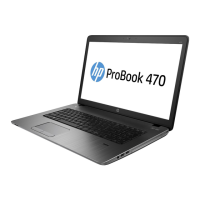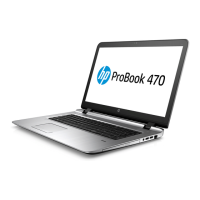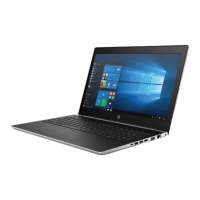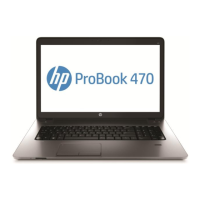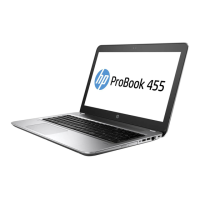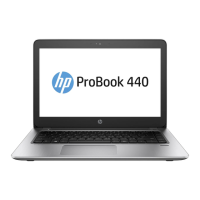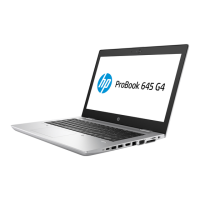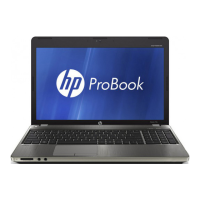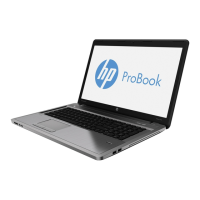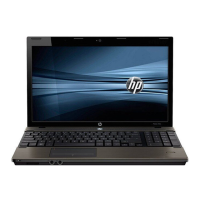Do you have a question about the HP ProBook 470 G4 and is the answer not in the manual?
Details processor, graphics, panel, memory, storage, and drive specifications.
Covers optical drives, wireless, ports, keyboard, touchpad, and system features.
Describes supported operating systems, security features like fingerprint reader, and power requirements.
Identifies and describes ports and components on the right, left, and bottom sides of the notebook.
Details display, top surface components (touchpad), indicator lights, buttons, and special keys.
Lists part numbers for major system components like system board, display, drives, and memory.
Details part numbers for accessory kits like Cables, Plastics, and Display hinges.
Covers tools, service considerations, grounding, and ESD precautions required before repairs.
Step-by-step instructions for replacing key components like battery, storage, memory, and system board.
Instructions for accessing, navigating, and configuring BIOS settings.
Guides on updating the BIOS and determining its version.
Information on using HP PC Hardware Diagnostics (UEFI) for troubleshooting.
Explains creating recovery media and restoring the system to factory settings.
Details processor, graphics, panel, memory, storage, and drive specifications.
Covers optical drives, wireless, ports, keyboard, touchpad, and system features.
Describes supported operating systems, security features like fingerprint reader, and power requirements.
Identifies and describes ports and components on the right, left, and bottom sides of the notebook.
Details display, top surface components (touchpad), indicator lights, buttons, and special keys.
Lists part numbers for major system components like system board, display, drives, and memory.
Details part numbers for accessory kits like Cables, Plastics, and Display hinges.
Covers tools, service considerations, grounding, and ESD precautions required before repairs.
Step-by-step instructions for replacing key components like battery, storage, memory, and system board.
Instructions for accessing, navigating, and configuring BIOS settings.
Guides on updating the BIOS and determining its version.
Information on using HP PC Hardware Diagnostics (UEFI) for troubleshooting.
Explains creating recovery media and restoring the system to factory settings.
| Form factor | Clamshell |
|---|---|
| Product type | Laptop |
| Product color | Silver |
| Country of origin | China |
| Memory slots | 2x SO-DIMM |
| Internal memory | 8 GB |
| Memory clock speed | 2133 MHz |
| Internal memory type | DDR4-SDRAM |
| Maximum internal memory | 16 GB |
| Memory layout (slots x size) | 1 x 8 GB |
| LED backlight | Yes |
| Display surface | Matt |
| Display diagonal | 17.3 \ |
| Intel segment tagging | Home Office, Small Business |
| On-board graphics card ID | 0x5916 |
| Discrete graphics card model | NVIDIA® GeForce® 930MX |
| On-board graphics card model | Intel® HD Graphics 620 |
| Discrete graphics card memory | 2 GB |
| Discrete graphics memory type | GDDR3 |
| On-board graphics card family | Intel® HD Graphics |
| Maximum on-board graphics card memory | 32 GB |
| On-board graphics card OpenGL version | 4.4 |
| On-board graphics card base frequency | 300 MHz |
| On-board graphics card DirectX version | 12.0 |
| On-board graphics card dynamic frequency (max) | 1050 MHz |
| SSD capacity | The Solid State Drive's storage capacity in Gigabytes. |
| Storage media | SSD |
| Optical drive type | DVD Super Multi DL |
| Total storage capacity | 256 GB |
| Compatible memory cards | SD, SDHC, SDXC |
| Number of SSDs installed | 1 |
| Front camera signal format | 720p |
| Wi-Fi standards | - |
| Bluetooth version | 4.2 |
| Ethernet LAN data rates | 10, 100, 1000 Mbit/s |
| Number of built-in speakers | 2 |
| USB 2.0 ports quantity | USB 2.0 ports have a data transmission speed of 480 Mbps, and are backwards compatible with USB 1.1 ports. You can connect all kinds of peripheral devices to them. |
| USB 3.2 Gen 2 (3.1 Gen 2) Type-A ports quantity | 0 |
| Sustainability certificates | EPEAT Gold, ENERGY STAR |
| Operating shock | 40 G |
| Operating altitude | -15.24 - 3048 m |
| Non-operating shock | 20 G |
| Operating vibration | 0.75 G |
| Non-operating altitude | -15.24 - 12192 m |
| Non-operating vibration | 1.5 G |
| Storage temperature (T-T) | -20 - 60 °C |
| Operating temperature (T-T) | 0 - 35 °C |
| Storage relative humidity (H-H) | 5 - 95 % |
| Operating relative humidity (H-H) | 10 - 90 % |
| AC adapter power | 65 W |
| Battery capacity | 48 Wh |
| Number of battery cells | 3 |
| Keyboard layout | QWERTY |
| Pointing device | Clickpad |
| Bus type | OPI |
| Stepping | H0 |
| Tjunction | 100 °C |
| Processor cache | 4 MB |
| System bus rate | 4 GT/s |
| Processor family | Intel® Core™ i7 |
| Processor socket | BGA 1356 |
| Processor threads | 4 |
| Processor codename | Kaby Lake |
| Configurable TDP-up | 25 W |
| Processor frequency | 2.7 GHz |
| Processor cache type | Smart Cache |
| Configurable TDP-down | 7.5 W |
| Processor lithography | 14 nm |
| Processor manufacturer | Intel |
| PCI Express slots version | 3.0 |
| Processor boost frequency | 3.5 GHz |
| Processor operating modes | 64-bit |
| PCI Express configurations | 1x2+2x1, 1x4, 2x2, 4x1 |
| Thermal Design Power (TDP) | 15 W |
| Configurable TDP-up frequency | 2.9 GHz |
| Configurable TDP-down frequency | 0.8 GHz |
| Maximum number of PCI Express lanes | 12 |
| Processor code | SR2ZV |
| Processor ARK ID | 95451 |
| Processor package size | 42 x 24 mm |
| Supported instruction sets | AVX 2.0, SSE4.1, SSE4.2 |
| Intel Identity Protection Technology version | 1.00 |
| Intel Stable Image Platform Program (SIPP) version | 0.00 |
| Depth | 280 mm |
|---|---|
| Width | 416.8 mm |
| Height | 25.8 mm |
| Weight | 2630 g |
